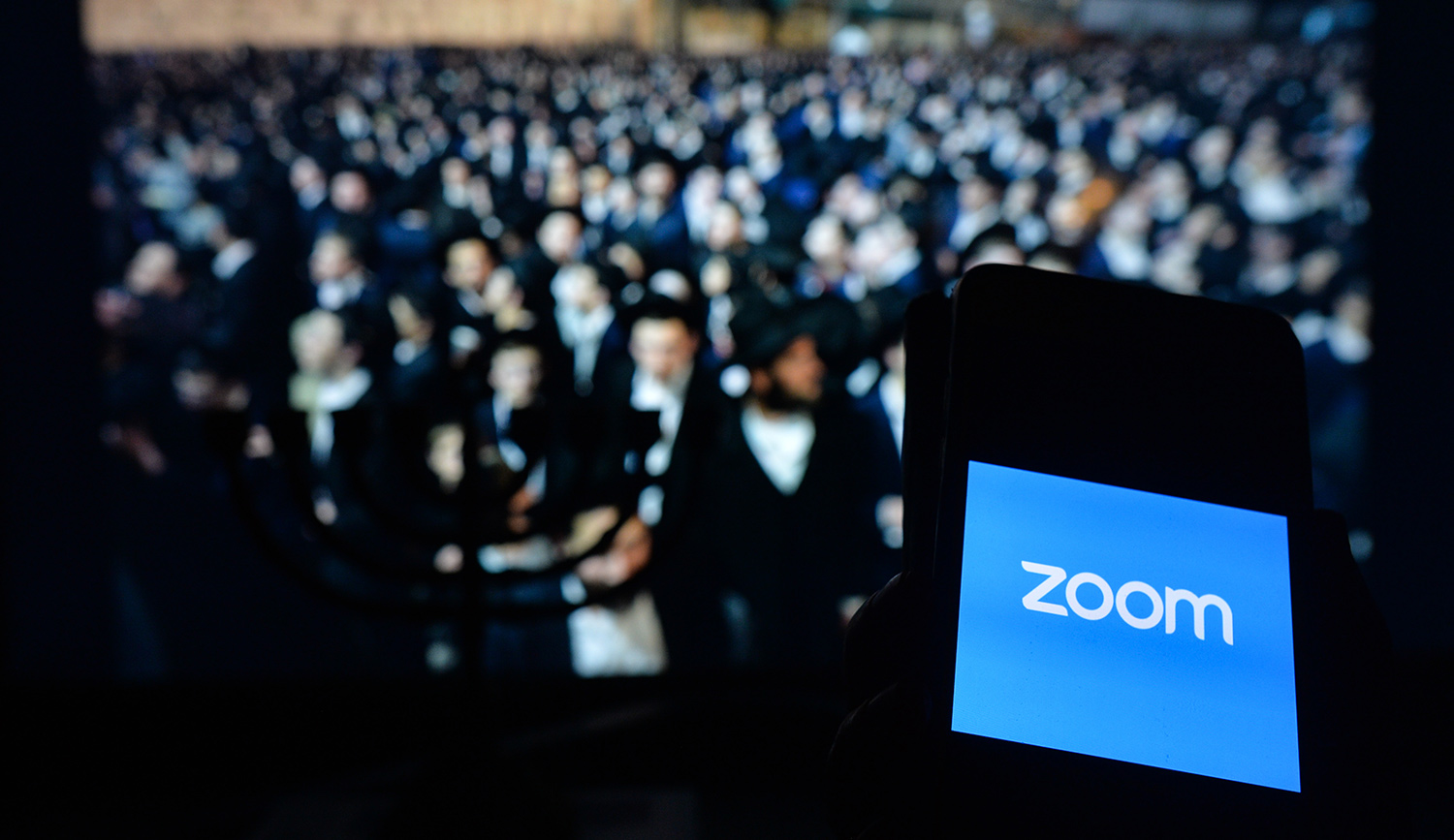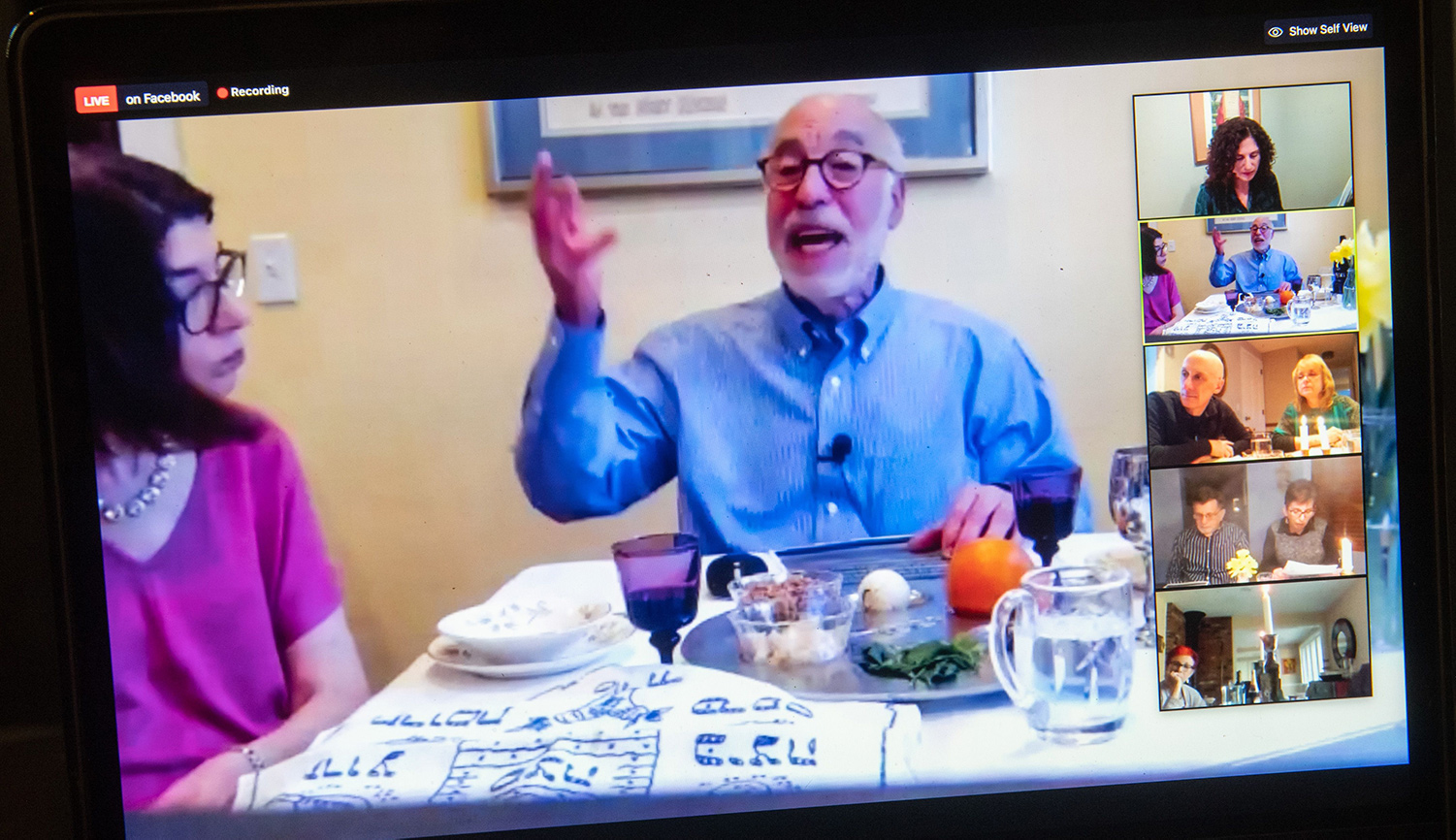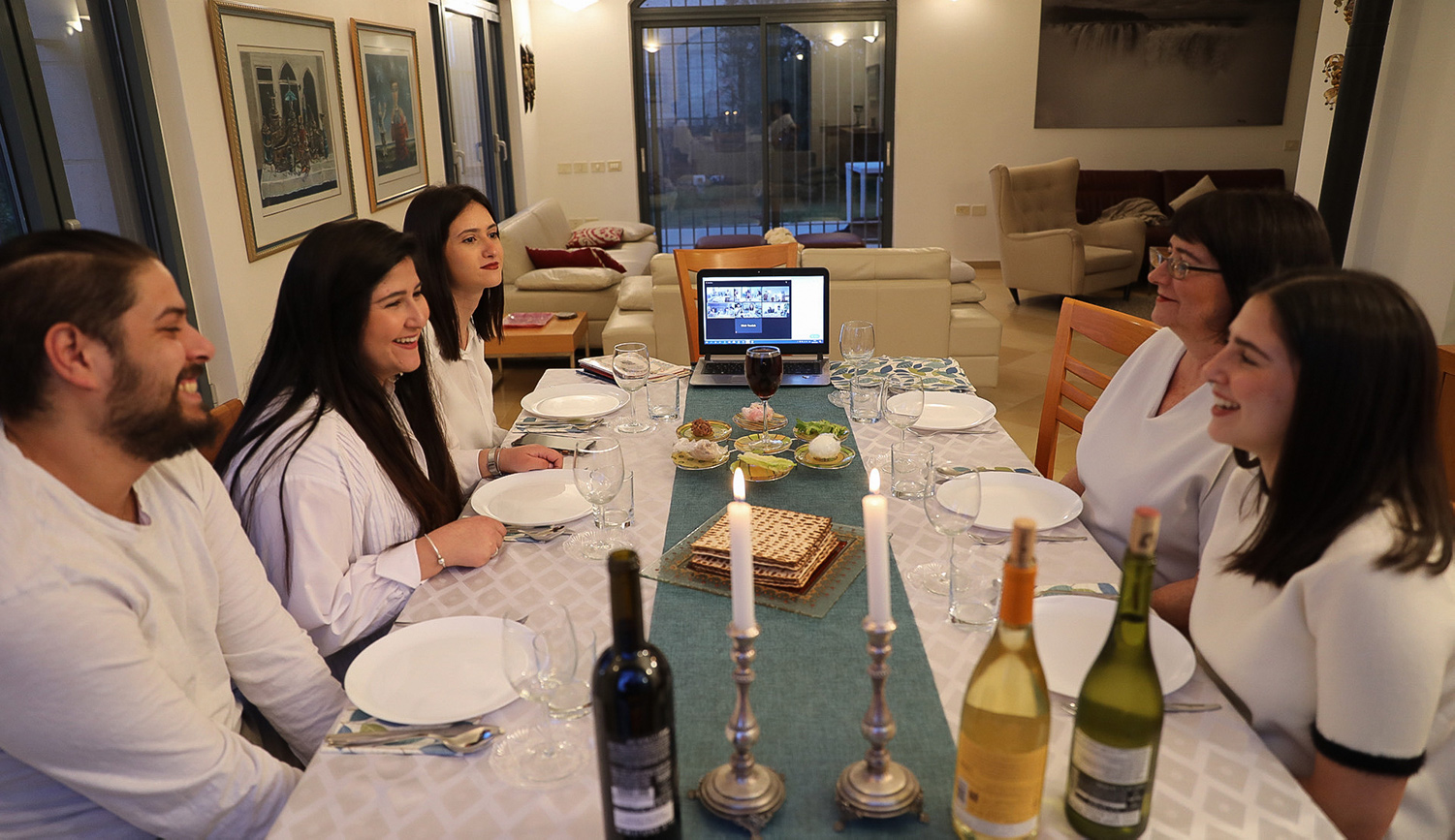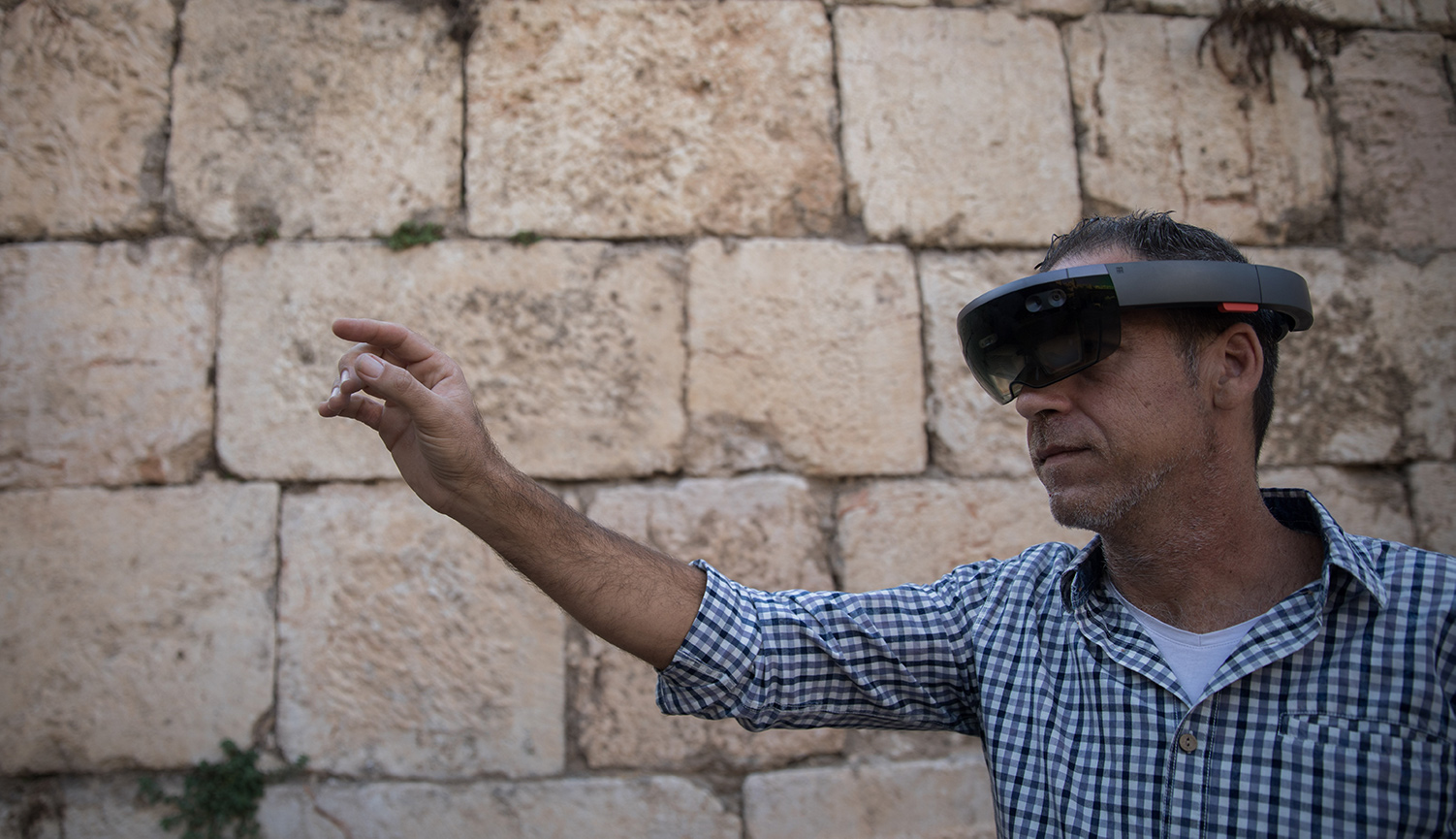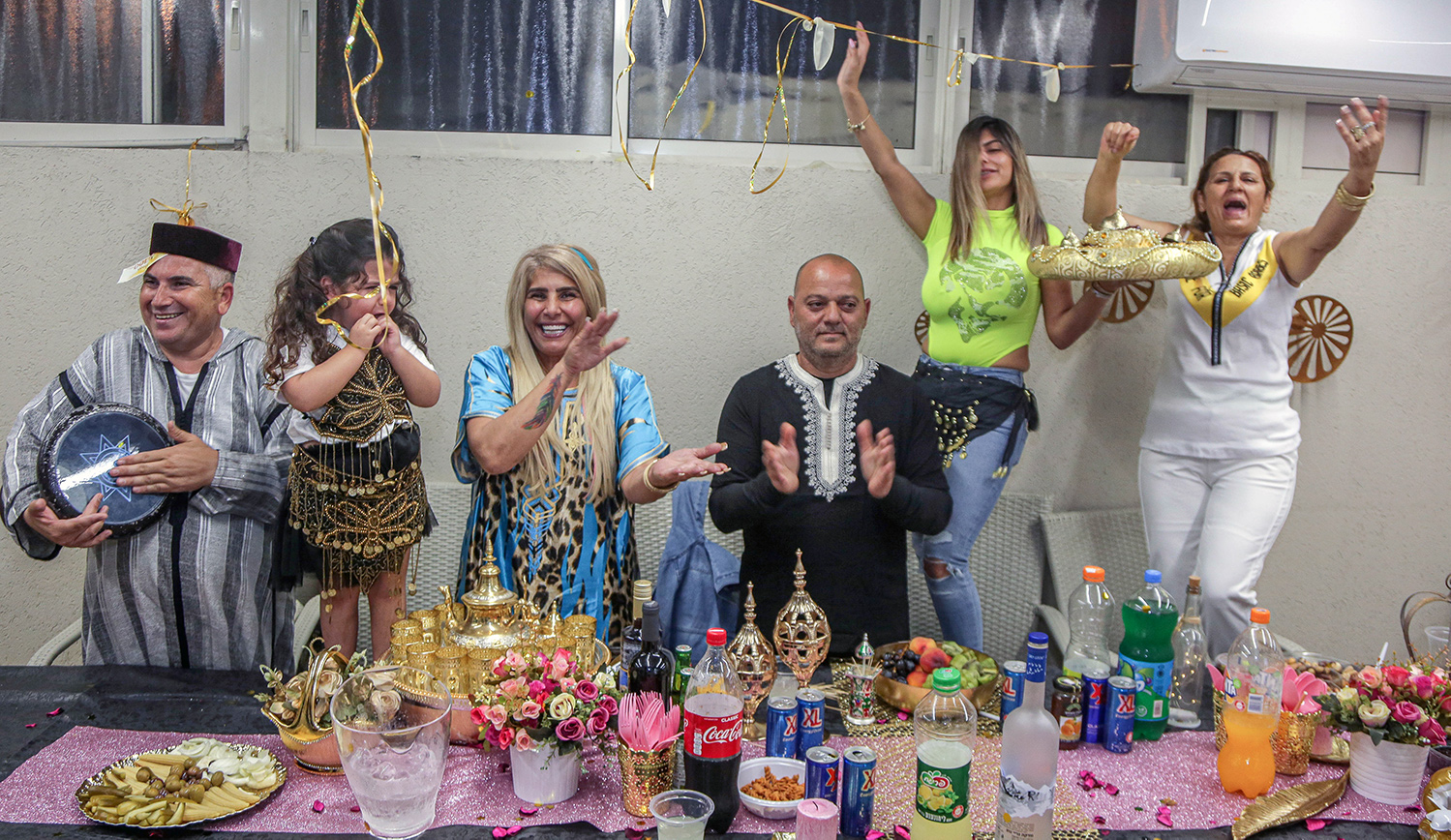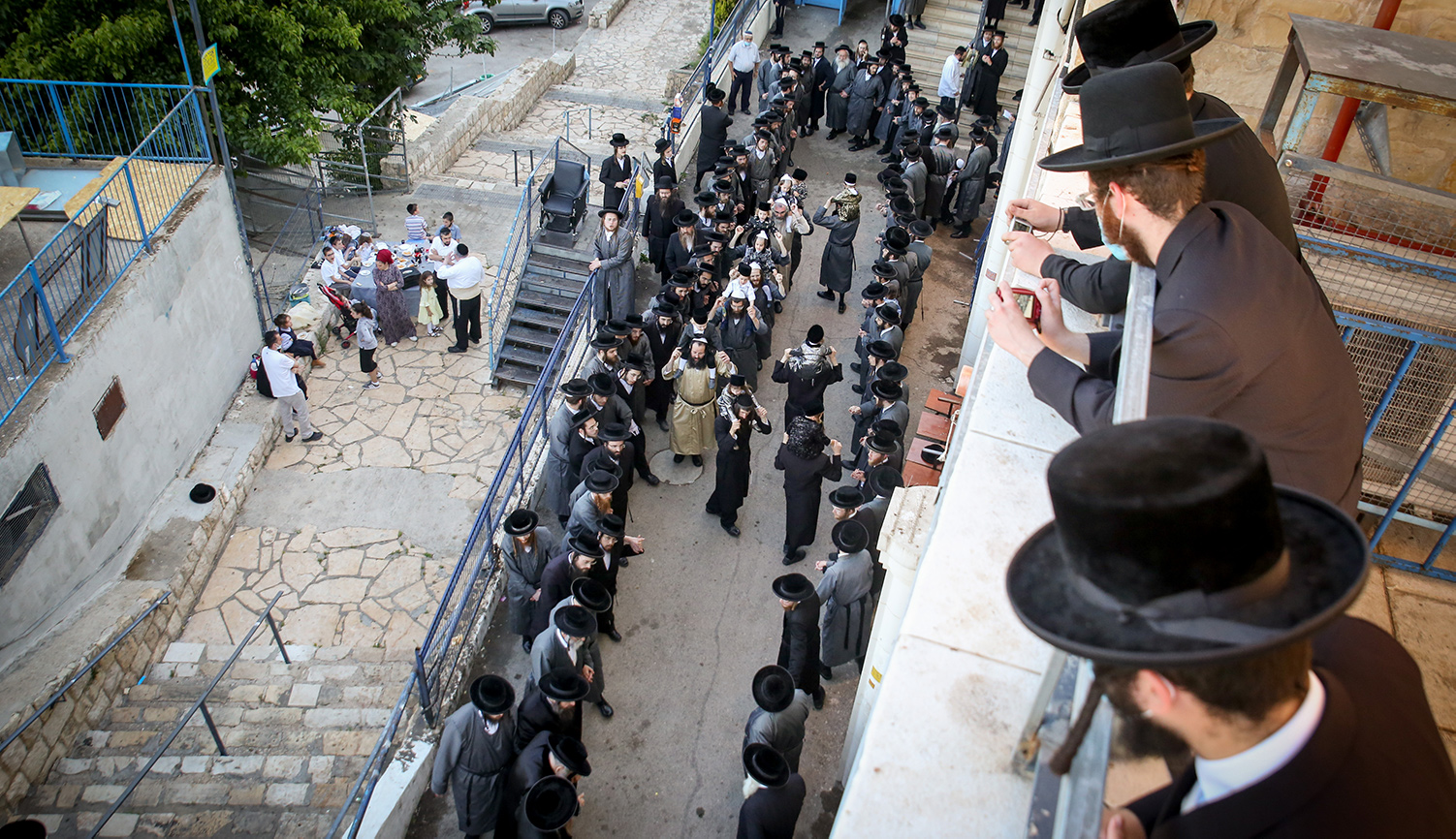Since cases of the novel coronavirus began appearing in Western countries a few months ago, life has changed in a very short span of time. Rising national economies have fallen. Political fortunes have turned. Once thriving sectors of the global economy, from energy production to entertainment, have shuttered.
For observant Jews, whose lives are governed by the complex web of regulations known as halakhah, the disease has presented its own unique problems. What, for instance, was to become of communal prayer given the necessity of social distancing? Could ritual baths (mikvahs), another essential part of religious life, remain open without becoming dangerous incubators of infection? And what of the classes, celebrations, and other public events that play such an important role in the social lives of these communities?
An added challenge came shortly thereafter in the form of Passover, which began on April 8—just after lockdowns went into effect in many places. With shortages in grocery stores and movement outside the home restricted, how would the holiday’s numerous dietary restrictions be observed? And then there was Passover’s central ritual, the seder, which by its nature and liturgy is oriented around a family meal. For most Jews, the solution was relatively simple: the telecommunication technology of the 21st century enabled family and friends to join together for the seder without leaving their homes. Thousands of Jews used the now-ubiquitous videoconferencing platform Zoom, which allows many more people to meet up virtually than was readily possible with earlier applications. So widespread was the “Zoom-seder” phenomenon that it was the subject of a Wall Street Journal article, and a screenshot from a Zoom seder casually found its way into a New York Times op-ed about the pandemic and the First Amendment. The topic even came up on the talk-show host Conan O’Brien’s podcast.
But for those Jews who refrain from using electronic devices on Sabbaths and holy days, the Zoom seder offered no solution at all. Or so it appeared until March 24, when a group of Orthodox rabbis known as the Association of Scholars of the Maghreb in the Land of Israel issued a ruling permitting those elderly who were in isolation to join their families for the seder via videoconference. The ruling traveled quickly across the Internet, and was soon picked up by the both the Hebrew- and English-language press. “Senior Orthodox Rabbis Allow Zoom for Passover Seder Due to Coronavirus,” blared one characteristic headline. Shared widely over social media, the story even inspired a parody skit on Israeli television, and was eventually reported by international news outlets ranging from the Agence-France Presse to Indonesia’s Jakarta Post. To many reporting on the story for the mainstream press, it appeared that not only was the pandemic having an effect on politics and economics, but it was even changing the very structures of religious life. Major halakhic reform usually proceeds through gradual shifts over the course of decades; the ruling from the Maghrebi rabbis appeared to draw back the curtain on halakhic reform rapidly taking place before the public eye.
But it wasn’t. The episode, as I’ll explain, indeed reveals much about the way that Jewish law evolves and its role in the totality of Jewish life—although not quite in the way it has been presented by outside observers. Most of all, the case of the Zoom seder demonstrates that rabbinic law doesn’t operate merely through the mechanical application of legal principles, but draws on more fundamental religious beliefs and on communal practices. Thus, while there might very well be technical legal reasons to permit the use of Zoom on holidays, most Orthodox rabbis rejected those reasons, not necessarily because they found their logic wanting, but because they sought to protect and strengthen an ideal of the Sabbath’s holiness in the digital age.
I. The Controversy
Founded in 2018, the Association of Scholars of the Maghreb in the Land of Israel is a group of rabbis, mostly of Moroccan origin, who seek to counterbalance contemporary Orthodoxy’s apparent tendency toward increasing stringency by drawing upon the presumably more lenient traditions of northwest-African Jewry. The ruling, as we shall see, is in keeping with that mission. Initially bearing the signatures of fourteen rabbis, this one-page Hebrew document swiftly addressed the plight of the elderly who would be unable to join their families for the seder because of the coronavirus, so long as the equipment is set up, and the video call begins, before the arrival of the holiday at sunset.
The ruling immediately received wall-to-wall condemnation from prominent Ashkenazi and Sephardi rabbis in Israel and the United States. One critic labeled it “erroneous” and called for its retraction. Others declared that it was a “warning sign” about the dangers of permitting certain technologies on the Sabbath and holidays. Contrary to their intent, perhaps the Maghrebi sages’ most notable accomplishment has been to unite rabbis in Israel and America, ranging from the firmly ultra-Orthodox to the liberal edge of Orthodoxy, and even the “traditional egalitarian” (but decidedly not Orthodox) Yeshivat Hadar—who all spoke out in opposition.
In the face of such pressure, at least two of the signatories to the ruling issued retractions within days. Other signatories responded publicly and defiantly, asserting that their critics failed to raise halakhically compelling counterarguments and lacked understanding of North African halakhic traditions; moreover, they claimed that the retractions were the result of rabbinic strong-arming rather than sober halakhic analysis.
And what of the laypeople? In the end, from the admittedly anecdotal evidence available to me, it seems that few people who would not have otherwise used Zoom on the holiday took advantage of the lenient ruling, regardless of ancestry.
The intense nature of these public reactions—both far beyond anything spurred by other coronavirus-related halakhic decisions—suggests that the statement issued by the “Rabbis of the Maghreb” touched a nerve, and for that reason alone it deserves careful analysis. But first we must understand the legal issue under debate, which will require us to understand how halakhah relates to electricity and the devices it powers.
In its enumeration of the annual holidays, the Torah names certain days on which, as on the Sabbath, “no work may be done”—among them the first day of Passover. The Talmud interprets this statement by applying the complex system of Sabbath prohibitions to these holy days, albeit with some important exceptions, mainly connected to cooking and lighting flames. As on the Sabbath, observant Jews do not drive cars, kindle fires, write, sew, launder clothing, or use electricity on the first day of Passover. (In the Diaspora, this extends to the second day as well.) Since the Jewish “day” begins in the evening at sunset, halakhah prohibits using Zoom, Skype, Facetime, or any other method of digital connection for the seders.
To those only reading the headlines, the logic of the now-famous Zoom ruling seemed to go something like this: “due to the extraordinary circumstances stemming from COVID-19, the prohibition on using electronics can be waived to allow extended families to gather for seders.” But anyone familiar with the process of halakhic decision making knows that more precise reasoning is generally at work.
For behind the Zoom-seder controversy lies an older debate, predating the Internet, about whether using electricity on Jewish holidays is different than using it on Shabbat. While those who forbade electricity’s use on holidays won out—a subject I’ll return to presently—a number of 20th-century North African halakhists expressly permitted it. Since this position deviates from the current Orthodox rabbinic consensus, and even most otherwise-observant Maghrebi Jews refrain from using electricity, our Moroccan rabbis did not advocate completely jettisoning the prohibition on electricity. They instead employed a classical tactic in rabbinic reasoning: in cases where a halakhic debate has been resolved in favor of a stringent opinion, one may still rely on the rejected lenient opinion under extenuating circumstances. Furthermore, the pro-Zoom rabbis didn’t go so far as to allow initiating a video call on the holiday: their ruling applies only when the seder participants have set up the equipment prior to sunset, so that no violations need occur once the holiday commences.
The lenient ruling rests on at least three mitigating factors: (1) since there is a recognized, minority holding to the effect that electricity may be used on the holiday, the rabbis are willing to make an exception in this particular case, (2) since the call would begin before the holiday, the Zoom-seder participants would not be actively using electricity during the hours of its prohibition, and (3) even if there is a risk that the participants might fiddle with the software, screen, or sound on the holiday itself, this derivative concern can be overridden given the circumstances brought about by a global pandemic.
After addressing several technical objections, the ruling turns to the positive goods afforded by a Zoom seder, explaining that, in the absence of their grandparents, younger generations might not participate in a seder at all. The absence of the young is a blow to the heart of the ritual, which is designed as a dialogue between parents and children: hence the four questions asked by the youngest present and the Torah’s repeated emphasis on parents discussing the Passover service with their children. While a one-generational Passover seder is technically possible, it goes against both the biblical vision of the holiday and centuries of lived practice.
The Moroccan rabbis’ document concludes by citing, “the need to remove the sadness from the aged and elderly, and to give them a motivation to carry on in their struggle for life, and to protect them from depression and spiritual distress, which could cause them to despair of life itself.”
II. What Makes This Ruling Different from All Other Rulings
The Zoom-seder controversy is by far the most discussed halakhic ruling arising out of the coronavirus pandemic, but it’s by no means obvious why this should be. Rabbis from across the Orthodox spectrum have taken lenient and sometimes surprising positions on a variety of matters, such as what items may be included in the ritualized sale of non-kosher-for-Passover goods to non-Jews before the holiday. Likewise, many expressly forbade the ritual burning of any remaining leaven on the eve of the holiday, since doing it publicly could risk infection and public outcry, and doing it on a porch or balcony, or indoors, posed obvious dangers of its own.
These decisions regarding Passover observance accompanied rulings on other topics, such as prohibiting communal prayer in order to prevent the spread of contagion, or allowing people to listen to recorded music during the customary period of mourning between Passover and Shavuot so as to alleviate the emotional toll of isolation. Nor were these rulings limited to ritual minutiae: rabbis have also considered such life-and-death questions as the rationing of ventilators.
Indeed, far-reaching halakhic decisions have in fact been newly promulgated in response to the coronavirus pandemic, and those decisions relate to health and wellbeing, and even life and death. Prominent rabbis have permitted those suffering from psychiatric illness to use phones and perhaps even Zoom itself on the Sabbath and holidays to speak to loved ones, seek the counsel of rabbis, call a doctor, or attend a virtual group-therapy session. They even encouraged fellow clergymen to keep their cell phones accessible over the course of the holiday should a distressed congregant call. Unlike the Zoom seder, these decisions do not rest on arguments about the use of electricity, but on a bedrock principle, known as pikuaḥ nefesh, that allows for almost all prohibitions to be overridden when a life is in danger.
Decisions undertaken in the name of pikuaḥ nefesh, which have been ratified by such mainstream institutions as the Rabbinical Council of America, demonstrate the rapid acceptance of halakhic innovation in response to COVID-19 in a way that the Zoom-seder ruling does not. They show an increasing willingness to accord the same gravity to mental health as to physiological health, and to consider “telemedicine” as comparable to other forms of medical treatment. Other rulings, especially relating to social-distancing guidelines, show an extension of the principle of pikuaḥ nefesh beyond obvious, acute, and immediate emergencies—such as using a phone to call an ambulance when someone is having a heart attack.
Under the emerging meaning, saving a life has expanded to include actions taken to reduce the statistical likelihood of coronavirus infection and further deaths. While these trends have been ongoing for some time, the current pandemic has accelerated the shift, and there is little doubt that we are witnessing an inflection point. Pikuaḥ nefesh is no longer solely about preventing person X from dying immediately from cause Y, but includes the broader justification of what we have come to know as public health.
Although rulings that rely on such expanded conceptions of medical necessity are proliferating, the Moroccan rabbis did not rest their case primarily on principles of pikuaḥ nefesh. They were instead ambiguous on this point, and it seems deliberately so. Rather than simply state that they want to save lives, they invoke the importance of young people connecting to Jewish tradition through their grandparents. This latter consideration, while surely a worthy goal, doesn’t meet the threshold of life-saving necessity normally required to permit violations of the Sabbath or a holiday.
A related criticism of the decision responds to the manner in which it was publicized. By issuing the ruling as a general policy statement, its authors appeared to offer blanket permission to a broad population rather than a narrow decision in response to specific facts. At least one of the original signatories who later retracted explained his reversal as stemming from the way the ruling was disseminated: he might be willing to permit a Zoom seder in a given case after careful consideration of a particular family’s circumstances, but was unwilling to stand behind an all-encompassing proclamation.
The gap between what is proclaimed in public and permitted in private allows rabbis to inject flexibility into a system that has a built-in aversion to explicit change. Though not without its drawbacks, this approach enables halakhists, when they so wish, to adopt stringent positions in public in order to fortify communal appreciation for the mandates of halakhah, while simultaneously indicating a willingness to be lenient under specific circumstances. In a public letter dated March 29, 2020, the Rabbinical Council of Bergen County, New Jersey made this tension overt, explaining that for “individuals with established and underlying psychiatric conditions, . . . or for other people in unique situations” threatened by isolation, “reasonable solutions can be presented on a case-by-case basis by your family [rabbi] in consultation with the relevant medical professionals.” Here, in contrast to Western law’s claims to universal applicability, halakhah operates a bit more like clinical medicine: studies may show that medication X is effective for condition Y, yet each patient is urged to consult with his or her doctor before taking it.
The legal grounds of the Zoom-seder ruling and the manner in which it was pronounced do not, however, explain sufficiently the overwhelming opposition it provoked among traditional halakhists. After all, the Rabbinical Council of America posted its opinion regarding mental illness in equally public fashion over its Facebook page. What, then, precipitated such a firm, across-the-board rejection? The answer reveals something about the very essence of the Sabbath and holidays. In this sense the seemingly inordinate media attention the ruling garnered was not disproportionate at all.
III. How Electricity Came to Be Forbidden
God of course, did not forbid the use of electronics on the Sabbath at Mount Sinai, nor did talmudic or medieval rabbis consider the issue. Thus before we can make sense of why videoconferencing seems such a grave violation to so many, we need to examine carefully how electricity came to be prohibited in the first place.
In the late 19th century, halakhists first confronted the question of electricity with the introduction of the incandescent light bulb. Most prohibited its use on the Sabbath on the grounds that illuminating a filament is akin either to lighting a flame or to heating an object, both of which halakhah flatly forbids. A precedent was set, and as new electrical appliances came into use that appeared neither to kindle nor to heat—first telegraphs, phones, and record players, and later televisions and computers—that precedent was followed as rabbis devised rationales to prohibit electricity on Shabbat across the board. Some argued that closing an electric circuit constitutes “building.” Others contended that since an electrical current creates sparks it is a form of igniting; or that using electricity is akin to completing a new object from its constituent parts; or else that electricity violates the rabbinic prohibition of begetting something new.
Obviously, none of these theories applied perfectly to all the relevant technology even then, much less now; indeed Rabbi Shlomo Zalman Auerbach, one of the leading halakhists of 20th-century Jerusalem, found all these approaches wanting. Yet he did not end up permitting the use of electricity on the Sabbath. Instead, he concluded that while electricity may not fit into any specific category of forbidden “work,” the real basis of its prohibition was precisely the fact that it was universally accepted by both the rabbinate and the laity; thus introducing to our examination the principle that some overriding rationale can be decisive even if it is not the product of close legal reasoning.
In most instances, there is no practical difference between Rabbi Auerbach’s conclusion and that of those authorities who saw the use of electricity as a violation of an express biblical commandment. But in unusual circumstances where rabbis feel the need to seek exceptions, the disagreement has real consequences. If the use of electricity violates a biblical commandment, the hurdle for waiving it in an emergency is much higher than it would be if it were a rabbinic enactment, or based in mere custom.
Moreover, the competing rationales for forbidding electricity on Shabbat lead to differing conclusions about whether it is prohibited on holidays, when the rules about heating and lighting are laxer. Halakhists who grounded the prohibition on using electricity in its similarity to igniting or cooking either permitted its use on holidays outright, or were at least open to making allowances in cases of significant need. Thus Mizraḥi rabbis—rabbis from communities of Jews originating in the Middle East rather than Europe—such as the late former Israeli chief rabbi Ben-Zion Ḥai Ouziel (1880-1953) and the former chief rabbi of Netanya David Ḥayyim Shloush (1920-2016)—alongside such prominent Ashkenazi halakhists as Yeḥiel Epstein (Russia, 1829-1908) and the American sage Joseph B. Soloveitchik (1903-1993)—all ruled leniently regarding some uses of electricity on holidays.
But over the past half-century or so, however, the consensus has moved to the stricter position adopted by Rabbi Moses Feinstein (1895-1986), one of the foremost American authorities of his day, and the leading Sephardi authority of the era, Israel’s chief rabbi Ovadia Yosef (1920-2013), who generally forbade using electricity on holidays. So overwhelming was this consensus that, once they emigrated to Israel, many Mizraḥi rabbis ceased recommending the practice; and in his later years, even Soloveitchik himself refrained from publicizing his permissive view out of deference to the majority.
Rather than exercise flexibility to keep up with the times, here halakhah has responded to our culture’s ubiquitous technology by becoming stricter. Recall that in Europe, North Africa, and America, lighting was the earliest use of in-home electricity, as bulbs were but a more convenient replacement for candlelight. Since on holidays one was always allowed to use an existing flame to transfer fire from one candle to another, turning electric bulbs on and off did not radically change the character of the day—especially as the “fire” of electricity was (rightly or wrongly) deemed already to “exist” within the wires. Fast-forward to today where permitting electricity entails access to screens and all workday activities. As the social meaning of “using electricity” has changed, it is no wonder the permissive rulings have fallen out of favor.
IV. The Essence of the Sabbath
To understand the rabbinic aversion to technological leniencies on Shabbat in all but dire situations, we ought to return to one of the oldest source-texts of these laws and reconstruct something of its underlying rationale. The earlier stratum of the Talmud, known as the Mishnah, compiled in the Galilee around 200 CE, enumerates 39 basic categories of labor forbidden on the Sabbath. Some—including writing, building, kindling, and cooking—remain essential to Orthodox Jews’ observance, while others, such as winnowing, threshing, and setting up a loom, have become far more obscure.
As explained by generations of scholars over the centuries, these 39 categories relate to the labors required for the provision of the basic needs of human life: food, from sowing seeds to kneading and baking dough; clothing, from shearing to sewing and weaving; and shelter, from constructing a building to kindling a fire to stay warm.
In Roman Palestine, and indeed for much of human history, these activities consumed most people’s daily routines. Even the lifestyles of the wealthy were made possible only because slaves engaged continuously in these labors, not at some far-away factory or farm, but often in the household itself. In the past few generations, however, they have become increasingly removed from daily experience. Few readers of this article have ever harvested crops, skinned animals, or knitted clothing. As a lived practice, for most observant Jews the prohibitions of Shabbat boil down to refraining from driving, cooking, and the use of electronic devices.
While the Moroccan rabbis may be technically correct in labeling the use of electronic devices a relatively minor legal issue, in the modern world the prohibition that makes the Sabbath most unlike the workday is that it is a day on which no “screen time” is allowed. Tellingly, this conception of the Sabbath has even started to gain purchase outside the confines of observant Judaism as both unaffiliated Jews and non-Jews have been calling for “digital Sabbaths”—periods of abstinence from computers and cell phones. Similarly, Rabbi Asher Weiss, a prominent Israeli halakhist, has written that “it is as if a voice came down for the heavens declaring that these devices may implicate a prohibition of biblical proportions.”
It is possible that, from a strictly legal perspective, further technological innovation will likely render electronic devices less of an issue on Shabbat than in the past. The incandescent lightbulbs of a century ago involved a relatively concrete sense of igniting, but what of the LEDs that illuminate our screens and homes? These produce no heat at all, leading some to argue that their use violates only rabbinic, rather than biblical, prohibitions. Similarly, it is only a matter of time before driving becomes more passive and less reliant on a human activating the ignition of an engine or otherwise controlling the car. The laws of the Sabbath threaten to become but one further design challenge, or as one religiously observant engineer put it, “tell me what Shabbat rules you want to account for, and I’ll design the workaround.”
Notably, ensuring that Shabbat reflect something not wholly captured by the formalities of its proscribed labors concerned ancient minds as well. The Talmud reads the prophet Isaiah’s somewhat enigmatic plea (58:13) to “keep your feet from breaking the Sabbath and from doing as you please on my holy day” as the basis for prohibiting business discussion on the Sabbath because they constitute “workaday activities.” In other cases, it seems as if the rabbis sought to force certain activities into the preexisting categories. For instance, the Talmud prohibits riding an animal on Shabbat lest one break off a branch to use it as a whip. It’s possible this was a genuine concern, but there is a mismatch between the underlying prohibition and the actual activity. Some have therefore argued that the break-the-branch argument was a post-hoc rationale to forbid pursuits that do not fit within the dominant understanding of the character of Shabbat.
This theme recurs in the halakhic literature throughout the centuries. Moses Maimonides, one of the greatest sages of the Middle Ages, followed Isaiah in ruling that “some acts are forbidden on the Sabbath even though they neither resemble nor lead to prohibited work.” Two generations later, another giant of halakhic scholarship, Moses Naḥmanides, explained that “we are commanded by the law of the Torah to refrain on the holidays even from activities that do not fall into the category of formal Shabbat labors.”
With the advent of the technological innovations of the modern era, rabbinic authorities drew on these sources to articulate how Shabbat would be observed in rapidly changing environments. Rabbi Moses Schreiber (a/k/a Ḥatam Sofer, 1762–1839) forbade traveling by rail on Shabbat on the grounds that the jostling caused by trains in his day prevented a person from enjoying the restful spirit of Shabbat. In the 20th century, the renowned Jerusalem halakhist, Rabbi Eliezer Waldenburg, employed similar reasoning to prohibit riding a bicycle.
Only a naïve observer would conclude that these rabbis were mechanistically applying preexisting laws to new situations. A cynic might say that these benighted sages dredged up the most far-fetched rationales owing to a fear of anything new or the censorious inclination to prohibit whenever possible. But something else entirely is at work here. Halakhic decisionmakers throughout the ages were defining an essence of the Sabbath not fully delineated by halakhah—or in, popular terminology, setting forth what is “shabbosdik.”
V. What Is Shabbosdik and Who Decides?
While Jewish law has long maintained, in one way or another, the category of “not shabbosdik”—not fitting conduct for the Sabbath—its boundaries are invariably fuzzy and contingent on custom. Two decades ago, the presence of screens on Shabbat in Orthodox synagogues was unheard of and decidedly not shabbosdik, yet today it is commonplace to see announcements of the schedule of services and other synagogue events crawl on the bottom of electronic bulletin boards that have been set up the day before. While outstanding scholars of every generation certainly play a role in formulating the relevant halakhic parameters, as our earlier example of Rabbi Auerbach intimates, those same authorities sometimes acknowledge their attention to the vox populi. As Rabbi Weiss put it, “the voice of the community is akin to voice of the divine.”
As new technologies become more difficult to avoid, communities face considerable pressure to prevent them from overrunning the Sabbath’s holiness. The current discussion is therefore less about whether any particular invention fits into a pre-existing category, than an ongoing dialogue between venerable talmudic doctrines, rabbinic authorities, and communal intuitions over how to distinguish between technological necessity and conveniences that infringe on Shabbat’s sanctity.
For example, when asked in the 1970s about the permissibility of using timers to turn on electric devices during Shabbat, Rabbi Moses Feinstein argued against it, warning that a permissive approach would transform the Sabbath into a regular workday powered by automation. Yet by that point it had become widespread custom to set timers on Friday to turn lights on and off on Shabbat. Despite his preference for banning timers altogether, Rabbi Feinstein was unable to do so. In succeeding decades it became common to employ timers for a variety of Shabbat uses including hotplates, fans, and air conditioners, not to mention the built-in thermostats that regulate HVAC systems, refrigerators, and other appliances.
And yet, there is near-universal understanding that Shabbat timers cannot be used to turn on the radio or the television or to arrange a coffeemaker to brew a cup for Saturday-morning breakfast. Likewise, while microphones are generally frowned upon, hearing aids are acceptable. Subway travel is inappropriate even if all technical obstacles can be overcome, while many are willing to use specially modified Shabbat-compliant elevators. Wearing a Fitbit or Apple watch is likely problematic, yet moving about a home, hotel room, or city street armed with sensors is often deemed permissible. Most recently, increased security concerns stemming from anti-Semitic attacks have driven many congregations to install technologies that record and monitor worshippers on Shabbat, even as they recoil at the thought of using preset cameras to memorialize a bar-mitzvah boy’s reading of the Torah.
Many have toiled mightily to ground these practices in technological and halakhic distinctions. And to be sure, they are not without talmudic precedent. But at bottom, how these rules are applied to various cases is more a function of social practice than of legal reasoning, and ultimately rests on a underlying intuitions of what is and is not shabbosdik. Indeed, halakhists themselves have acknowledged taking communal standards into account in formulating their decisions.
Seen in this light, a commonsense logic is apparent in these distinctions even to those not steeped in talmudic argumentation. Microphones that create loud noise overtly change Shabbat’s atmosphere and are prohibited, whereas discreet personal hearing aids are not. A noisy radio allows the outside world to penetrate the serenity of the Sabbath in ways that a noisy air conditioner does not. Subways enable travel beyond the local Shabbat-observing community, while, in dense cities filled with high rises, elevators enable these communities to form. A Fitbit wearer signals a desire to be tracked and measured, while someone moving about in a smart home is merely walking around the house. And security cameras working in the background are different than those intended to capture a celebratory moment.
These lines are invariably imprecise, shifting, and not always fully satisfying. Yet the emergent consensus seeks to differentiate between technologies that are relatively unavoidable, passive, and discreet, and those deliberately engaged for real-time responses that command our attention. When it comes to the former, rabbis will deploy all manner of halakhic legerdemain and technological workarounds to seek compromise. But as to the latter, no matter how compelling the electromechanical analysis, nor how many formal halakhic solutions are proposed, observant communities and their rabbis will resist altering the character of Sabbaths and holidays. Just as refraining from agricultural work gave Shabbat its sacred character in earlier times, so too stepping back from the world of complete interconnectivity gives it its sacred character in the present.
And this brings us back to the Zoom seder. The coronavirus crisis has undeniably wrought unprecedented psychic and physical challenges—foremost to the elderly. It has also meant that virtual interactions have replaced real-life ones, as meetings, classes, lectures, and even social gatherings now take place over Zoom.
These shifts all emphasize how, more than any other object, the screen has become the totemic signifier of our inescapably digital modern lives. Our workweek, our obligations, our deadlines, and our modern stresses are all mediated by the screen, through which we access news, politics, and business, the secular and the profane. This barely three-dimensional portal draws us away from our immediate familial and spiritual setting into the vast expanse of the human universe. Few objects draw greater contrast to the Torah’s concept of shabbaton—cessation—that Sabbath and holidays aim to impart. In short, the screen represents all that is prohibited on Shabbat.
Thus, for most Orthodox rabbis and their communities, the image of a seder night centered on a table graced with matzah, bitter herbs, haroset, the Haggadah, wine . . . and a computer screen was simply too jarring and discordant to contemplate even in these dire times. Traditionalist rabbis have adopted all manner of leniencies to ameliorate the suffering and isolation caused by the coronavirus, but in rejecting the Zoom seder, they sought to protect people from the vertiginous speed of modern life itself. And one need not be halakhically observant to appreciate this protection.
More about: Coronavirus, Halakhah, Jewish law, Politics & Current Affairs, Religion & Holidays, Seder
